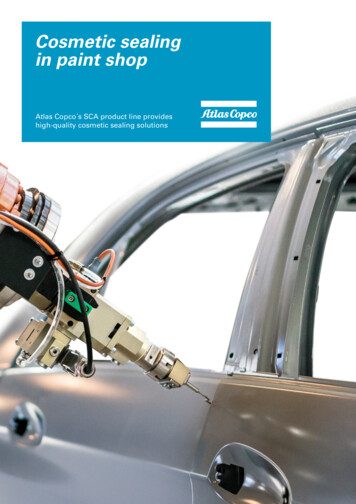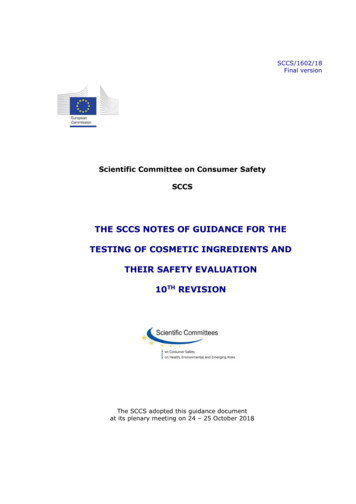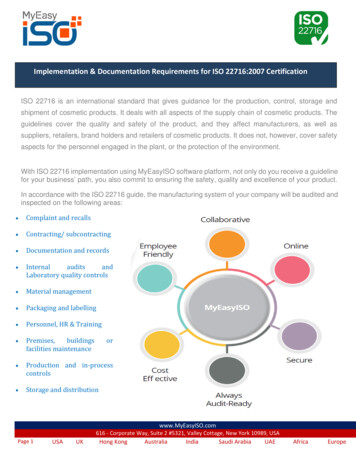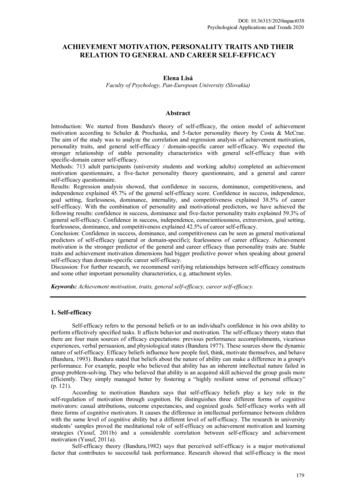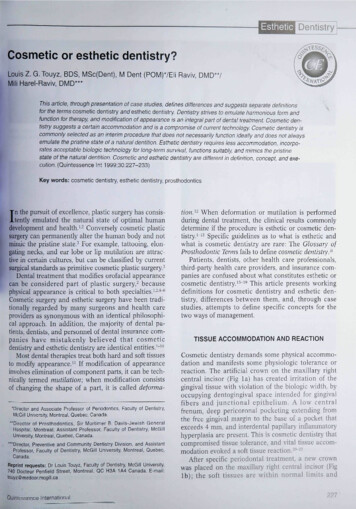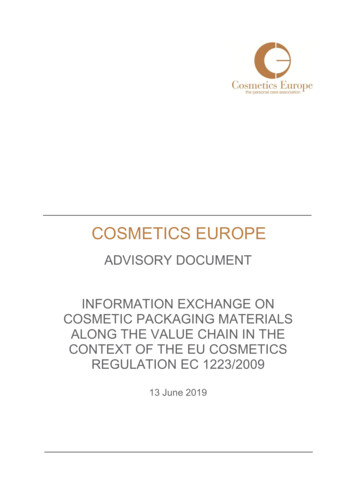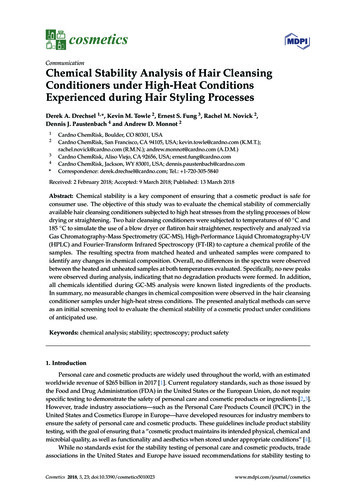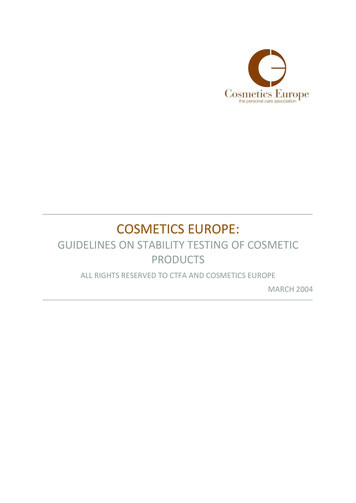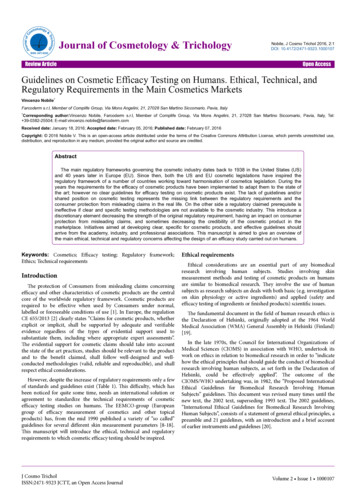
Transcription
chologyTriurnal of CJo&metologyosJournal of Cosmetology & TrichologyNobile, J Cosmo Trichol 2016, 2:1DOI: 10.4172/2471-9323.1000107ISSN: 2471-9323Review ArticleOpen AccessGuidelines on Cosmetic Efficacy Testing on Humans. Ethical, Technical, andRegulatory Requirements in the Main Cosmetics MarketsVincenzo Nobile*Farcoderm s.r.l, Member of Complife Group, Via Mons Angelini, 21, 27028 San Martino Siccomario, Pavia, Italy*Corresponding author:Vincenzo Nobile, Farcoderm s.r.l, Member of Complife Group, Via Mons Angelini, 21, 27028 San Martino Siccomario, Pavia, Italy, Tel: 39-0382-25504; E-mail:vincenzo.nobile@farcoderm.comReceived date: January 18, 2016; Accepted date: February 05, 2016; Published date: February 07, 2016Copyright: 2016 Nobile V. This is an open-access article distributed under the terms of the Creative Commons Attribution License, which permits unrestricted use,distribution, and reproduction in any medium, provided the original author and source are credited.AbstractThe main regulatory frameworks governing the cosmetic industry dates back to 1938 in the United States (US)and 40 years later in Europe (EU). Since then, both the US and EU cosmetic legislations have inspired theregulatory framework of a number of countries working toward harmonisation of cosmetics legislation. During theyears the requirements for the efficacy of cosmetic products have been implemented to adapt them to the state ofthe art; however no clear guidelines for efficacy testing on cosmetic products exist. The lack of guidelines and/orshared position on cosmetic testing represents the missing link between the regulatory requirements and theconsumer protection from misleading claims in the real life. On the other side a regulatory claimed prerequisite isineffective if clear and specific testing methodologies are not available to the cosmetic industry. This introduce adiscretionary element decreasing the strength of the original regulatory requirement, having an impact on consumerprotection from misleading claims, and sometimes decreasing the credibility of the cosmetic product in themarketplace. Initiatives aimed at developing clear, specific for cosmetic products, and effective guidelines shouldarrive from the academy, industry, and professional associations. This manuscript is aimed to give an overview ofthe main ethical, technical and regulatory concerns affecting the design of an efficacy study carried out on humans.Keywords: Cosmetics; Efficacy testing; Regulatory framework;Ethics; Technical requirementsIntroductionThe protection of Consumers from misleading claims concerningefficacy and other characteristics of cosmetic products are the centralcore of the worldwide regulatory framework. Cosmetic products arerequired to be effective when used by Consumers under normal,labelled or foreseeable conditions of use [1]. In Europe, the regulationCE 655/2013 [2] clearly states “Claims for cosmetic products, whetherexplicit or implicit, shall be supported by adequate and verifiableevidence regardless of the types of evidential support used tosubstantiate them, including where appropriate expert assessments”.The evidential support for cosmetic claims should take into accountthe state of the art practices, studies should be relevant to the productand to the benefit claimed, shall follow well-designed and wellconducted methodologies (valid, reliable and reproducible), and shallrespect ethical considerations.However, despite the increase of regulatory requirements only a fewof standards and guidelines exist (Table 1). This difficulty, which hasbeen noticed for quite some time, needs an international solution oragreement to standardize the technical requirements of cosmeticefficacy testing studies on humans. The EEMCO-group (Europeangroup of efficacy measurement of cosmetics and other topicalproducts) has, from the mid 1990 published a variety of “so called”guidelines for several different skin measurement parameters [8-18].This manuscript will introduce the ethical, technical and regulatoryrequirements to which cosmetic efficacy testing should be inspired.J Cosmo TricholISSN:2471-9323 JCTT, an Open Access JournalEthical requirementsEthical considerations are an essential part of any biomedicalresearch involving human subjects. Studies involving skinmeasurement methods and testing of cosmetic products on humansare similar to biomedical research. They involve the use of humansubjects as research subjects an deals with both basic (e.g. investigationon skin physiology or active ingredients) and applied (safety andefficacy testing of ingredients or finished products) scientific issues.The fundamental document in the field of human research ethics isthe Declaration of Helsinki, originally adopted at the 1964 WorldMedical Association (WMA) General Assembly in Helsinki (Finland)[19].In the late 1970s, the Council for International Organizations ofMedical Sciences (CIOMS) in association with WHO, undertook itswork on ethics in relation to biomedical research in order to “indicatehow the ethical principles that should guide the conduct of biomedicalresearch involving human subjects, as set forth in the Declaration ofHelsinki, could be effectively applied”. The outcome of theCIOMS/WHO undertaking was, in 1982, the “Proposed InternationalEthical Guidelines for Biomedical Research Involving HumanSubjects” guidelines. This document was revised many times until thenew text, the 2002 text, superseding 1993 text. The 2002 guidelines,“International Ethical Guidelines for Biomedical Research InvolvingHuman Subjects”, consists of a statement of general ethical principles, apreamble and 21 guidelines, with an introduction and a brief accountof earlier instruments and guidelines [20].Volume 2 Issue 1 1000107
Citation:Nobile V (2016) Guidelines on Cosmetic Efficacy Testing on Humans. Ethical, Technical, and Regulatory Requirements in the MainCosmetics Markets. J Cosmo Trichol 2: 1000107. doi:10.4172/2471-9323.1000107Page 2 of 10Standard/guidelineDescriptionReferenceSensory analysis -- Methodology -- Initiation and ISO 5496:2006 describes several types of method for determining the aptitude of assessors [3]training of assessors in the detection and and for training assessors to identify and describe odoriferous products.recognition of odours”Cosmetics -- Sun protection test methods -- ISO/TR 26369:2009 reviews and evaluates the methods which are currently used to assess, [4]Review and evaluation of methods to assess the for regulatory or self-regulatory purposes, the photoprotection of sun protection productsphotoprotection of sun protection products.applied on human body.Cosmetics -- Sun protection test methods -- In vivo ISO 24444:2010 provides a basis for the evaluation of sunscreen products for the protection [5]determination of the sun protection factor (SPF)of human skin against erythema induced by solar ultraviolet raysCosmetics -- Sun protection test methods -- In vivo ISO 24442:2011 provides a basis for the evaluation of sunscreen products for the protection [6]determination of sunscreen UVA protection.of human skin against UVA radiation from solar or other light sources.Final Rule 39: Labeling and Effectiveness Testing: 76FR35619 provides a basis for the evaluation of sunscreen products for the protection of [7]Sunscreen Drug Products for Over-the-Counter human skin against erythema induced by solar ultraviolet rays.Human UseEEMCO guidance for the assessment of skin The manuscript introduces the origins of skin colours and the basic principles of their [8]colour.measurement. Methods of colour reading are reviewed with particular insight into practicalprocedures, pitfalls and correct interpretation of data.EEMCO guidance for the assessment of skin The manuscript reviews the advantages and drawbacks of the currently used methods to [9]topography.assess skin microrelief/wrinkles and lists some experimental recommendations to make theresults of studies using these methods, more reliable.EEMCO guidance to the in vivo assessment of The manuscript reviews the physiological variables, ageing and skin diseases in altering the [10]tensile functional properties of the skin. Part 1: tensile functions of the skin.relevance to the structures and ageing of the skinand subcutaneous tissues.EEMCO guidance for the in vivo assessment of The manuscript reviews the advantages and drawbacks of the currently used methods to [11]skin greasiness.assess skin greasiness.EEMCO guidance to the in vivo assessment of The manuscript reviews the advantages and drawbacks of the currently used methods [12]tensile functional properties of the skin. Part 2: (tensile, torsional, indentation, impact and elevation modes) to assess the tensile functions ofinstrumentation and test modes.the skin.EEMCO guidance for the assessment of The manuscript reviews the advantages and drawbacks of the currently used methods to [13]transepidermal water loss in cosmetic sciences.assess transepidermal water loss.EEMCO guidance for the measurement of skin The manuscript reviews the advantages and drawbacks of the currently used methods to [14]microcirculation.assess skin microcirculation.EEMCO guidance for the in vivo assessment of The manuscript reviews the conditions to assess the pH of the skin.skin surface pH.[15]EEMCO guidance for the efficacy assessment of The manuscript reviews the advantages and drawbacks of the currently used methods to [16]antiperspirants and deodorants.assess the efficacy of deodorants and antiperspirants.EEMCO guidance for the assessment of hair The manuscript reviews the advantages and drawbacks of the currently used methods to [17]shedding and alopecia.assess skin hair shedding and alopecia.Inter-instrumental variation of skin capacitance The manuscript review the advantages and drawbacks of the currently used methods to [18]measured with the Corneometerassess skin moisturizationTable 1: Standards and guidelines for efficacy testing of cosmetics on humans.American regulations governing the conduct of biomedical researchinvolving human participants were published in 1981 by the federalDepartment of Health and Human Services (DHHS, formerly theDepartment of Health, Education and Welfare). Most US health careinstitutions conducting research have now agreed to apply thesefederal regulations to all of their research protocols regardless of thefunding source for a particular study. Additionally, numerous otherfederal agencies have adopted the DHHS regulations, as subsequentlyamended, as a Common Rule to protect human participants in anyresearch protocol. Research involving the testing of investigationaldrugs or medical devices is regulated concurrently by the federal FoodJ Cosmo TricholISSN:2471-9323 JCTT, an Open Access Journaland Drug Administration (FDA); the Common Rule and FDArequirements overlap considerably but are not completely identical[21]. The Food and Drug Administration’s (FDA’s) regulations for theconduct of clinical trials, which have been in effect since the 1970s,address both GCP and human subjects protection (HSP).Studies on cosmetic active ingredients and finished cosmeticproducts should be carried out in accordance with the principles of the“Declaration of Helsinki” [19] and the “Good Clinical Practice”guidelines [22]; national regulations regarding human studies shouldalso be considered. Efficacy testing should be carried out only whenVolume 2 Issue 1 1000107
Citation:Nobile V (2016) Guidelines on Cosmetic Efficacy Testing on Humans. Ethical, Technical, and Regulatory Requirements in the MainCosmetics Markets. J Cosmo Trichol 2: 1000107. doi:10.4172/2471-9323.1000107Page 3 of 10there is evidence that the product is safe for its use on humanvolunteers and safety should always “co-tested” as a secondaryobjective in a cosmetic efficacy study (e.g., by observing any adversereaction). As a consequence efficacy testing should be preceded by anextensive safety assessment of each cosmetic ingredient in the productformula and by safety testing (e.g. patch testing, photoirritation testing,etc.) in order to exclude local or systemic adverse reactions. The designof the study protocol should minimize the risks related to product(s)use/application and to protocol procedures. A risk/benefit ratioanalysis should be carried out during the design of the study protocol.However, differently of what happens for study carried withtherapeutic interventions, the study should be carried out only if risksare absent or minimal. In Table 2 are summarized the minimum set ofethical requirements to which cosmetic efficacy testing should beinspired. Implementation of the ethical requirements reported in Table2 is recommended in order to take into account specific needs orrequirements of the study protocol.The study should be ethically and scientifically justifiable: Among the essential features of ethically justified research involving human subjects are that the researchoffers a means of developing information not otherwise obtainable, that the design of the research is scientifically sound, and that the investigators and other researchpersonnel are competent. The methods to be used should be appropriate to the objectives of the research and the field of study. Investigators and sponsors must alsoensure that all who participate in the conduct of the research are qualified by virtue of their education and experience to perform competently in their roles.The study protocol should be submitted for review of its scientific merit and ethical acceptability to one or more Scientific Review and ethical review committees.Scientific review According to the Declaration of Helsinki, the research involving humans must conform to generally accepted scientific principles, and be based on athorough knowledge of the scientific literature and other relevant sources. Scientific review must consider, inter alia, the study design, including the provisions foravoiding or minimizing risk and for monitoring safety. Ethical Review The ethical review committee is responsible for safeguarding the rights, safety, and well-being ofthe research subjects. Scientific review and ethical review cannot be separated: scientifically unsound research involving humans as subjects is ipso facto unethical inthat it may expose them to risk or inconvenience to no purpose; even if there is no risk of injury, wasting of subjects’ and researchers’ time in unproductive activitiesrepresents loss of a valuable resource.All study participants should sign a written informed consent before the study begins. Informed consent is a decision to participate in research, taken by a competentindividual who has received the necessary information; who has adequately understood the information; and who, after considering the information, has arrived at adecision without having been subjected to coercion, undue influence or inducement, or intimidation. Process obtaining informed consent is a process that is begunwhen initial contact is made with a prospective subject and continues throughout the course of the study. By informing the prospective subjects, by repetition andexplanation, by answering their questions as they arise, and by ensuring that each individual understands each procedure, investigators elicit their informed consentand in so doing manifest respect for their dignity and autonomy. Language informing the individual subject must not be simply a ritual recitation of the contents of awritten document. Rather, the investigator must convey the information, whether orally or in writing, in language that suits the individual’s level of understandingcomprehension. The investigator must then ensure that the prospective subject has adequately understood the information. The investigator should give each one fullopportunity to ask questions and should answer them honestly, promptly and completely. Documentation of consent. The subject sign a consent form. Waiver of theconsent requirement. Investigators should never initiate research involving human subjects without obtaining each subject’s informed consent. Renewing consent.When material changes occur in the conditions or the procedures of a study, and also periodically in long-term studies, the investigator should once again seekinformed consent from the subjects.Participation in the study should be free. Subjects may be reimbursed for lost earnings, travel costs and other expenses incurred in taking part in a study. Thepayments should not be so large to induce prospective subjects to consent to participate in the research against their better judgment (‘‘undue inducement’’).Acceptable recompense. Study participants may be reimbursed for their transport and other expenses associated with their participation in the study. Those whoreceive no direct benefit from the study may also receive a small sum of money for inconvenience due to their participation in the study. Payments in money or in kindshould not be so large as to persuade eligible subjects to participate in the study. Unacceptable recompense. Payments in money or in kind to research subjectsshould not be so large as to persuade them to take undue risks or volunteer against their better judgment. Payments or rewards that undermine a person’s capacity toexercise free choice invalidate consent. Withdrawal from a study. A subject who withdraws from research for reasons related to the study, such as unacceptable sideeffects of the tested product or who is withdrawn on health grounds, should be paid or recompensed as if full participation had taken place. A subject who withdrawsfor any other reason should be paid in proportion to the amount of participation.Before any participant is exposed to the test product, all safety information regarding the product and its individual ingredients are assessed. All the precautions shouldbe taken in order to avoid adverse skin reactions occurrence. The Declaration of Helsinki in several paragraphs deals with the wellbeing of research subjects and theavoidance of risk. Thus, considerations related to the well-being of the human subject should take precedence over the interests of science and society. Clinical testingmust be preceded by a safety assessment (according to Annex 1 of Regulation CE 1223/2009), by adequate laboratory experimentation (when applicable), orscreening tests (e.g. patch testing) to demonstrate a reasonable probability of success without undue risk. Every project should be preceded by careful assessment ofpredictable risks and burdens in comparison with foreseeable benefits to the subject or to others; physician-researchers must be confident that the risks involved havebeen adequately assessed and can be satisfactorily managed.Individuals who are not capable of giving informed consent or research in populations and communities with limited resources should not participate in cosmeticproducts testing. Certain individuals or groups may have limited capacity to give informed consent either because, as in the case of prisoners, their autonomy islimited, because they have limited cognitive capacity or their resources are limited. All of these conditions limit the capacity to make an informed choice, are notmeeting the standard of informed consent, and then are not ethically justifiable.In case of non-expected/adverse skin reaction occurrence the medical investigating specialist should assess the severity of the reaction (reporting it in the datacollecting sheet of the volunteer) and as a consequence start the appropriate therapy. Investigators should ensure that research subjects who suffer injury as a resultof their participation are entitled to free medical treatment for such injury and to such financial or other assistance as would compensate them equitably for anyresultant impairment. Before the research begins, the sponsor, should agree to provide an adequate medical treatment or a compensation for any physical injury forwhich subjects are entitled to compensation.All the information about the study participant should be safeguarded confidentially. Research relating to individuals and groups may involve the collection and storageof information that, if disclosed to third parties, could cause harm or distress. Investigators should arrange to protect the confidentiality of such information by, forexample, omitting information that might lead to the identification of individual subjects, limiting access to the information, anonymizing data, or other means. Duringthe process of obtaining informed consent the investigator should inform the prospective subjects about the precautions that will be taken to protect confidentiality.Table 2: Ethical requirements for cosmetic efficacy testing Adapted from [20].J Cosmo TricholISSN:2471-9323 JCTT, an Open Access JournalVolume 2 Issue 1 1000107
Citation:Nobile V (2016) Guidelines on Cosmetic Efficacy Testing on Humans. Ethical, Technical, and Regulatory Requirements in the MainCosmetics Markets. J Cosmo Trichol 2: 1000107. doi:10.4172/2471-9323.1000107Page 4 of 10Even for clinical testing under a controlled environment, forexample, by a cosmetic testing organization, the responsibility for thesafety of the test product ultimately remains at the manufacturer.Often, a manufacturers wants to keep confidential the existing data onthe test product (e.g., ingredients). However, the testing organizationshould at least insist on a confirmation by the manufacturer or by itssafety assessor that the safety assessment and toxicological profile ofthe test product was considered and the test product was judged safeunder the normal conditions or foreseeable conditions of use.Furthermore, it should be confirmed by the manufacturer that the testproduct conforms to the local cosmetics laws. In general, it should bekept in mind that the ingredients list is very helpful for testing. First, tobe able to protect test volunteers by excluding them from the study ifthey already have a known hypersensitivity to a certain cosmeticingredient this is contained in the test product. Second, an experiencedtesting organization can give recommendation on the correct choice ofthe adequate study design to meet the study objectives, which is oftencritically dependent on the general characteristics of the product, theformulation type, or certain ingredients.Even if, an independent safety review is not legally required forcosmetic tests, this should always be considered, at least if a residualrisk for the volunteers is suspected, for example, if the test productcontains novel ingredients, or if invasive or stressful subject proceduresare planned for the study.Technical requirementsIn order to promote sound scientific design of research, eachcosmetic efficacy testing study protocol should include a series ofdetailed information on how to carry out the study (Table 3) [23].The saying “the claim dictates the test” is a good starting point whenconsidering whether and what type of clinical study is needed.Different study designs provide different strength and limitation. Thegold standard of clinical study designs is the randomized controlledstudy (RCT). According to this study design, treatments (e.g. activeingredient and placebo or active ingredient and benchmark) areallocated to subjects in a random and unpredictable sequence.However, if this is not feasible, then an observer-blind or single-blinddesign may be sufficient. In these cases, the assessor or subject isunaware of the test product assignment. In order to reduce thevariability due to differences between individuals, designs withintraindividual comparison (e.g. half-face/half-body application,multiple applications on forearm, etc.) of test products are generallypreferred in cosmetic testing, if feasible. A random allocation of thetest products or untreated control/placebo product should be used inthese designs. Blinding is also one of the major concerns in studydesigning. In addition to RCTs there is a number of study types thatthe investigator can choose in the clinical trial field that are alsoapplicable to cosmetic efficacy studies. The choice of the study designand type should take into account the nature of the claim (e.g.ingredients claims, performance claims, sensory/aesthetic claims,combination claims, comparison claims) and the strength of the studydesign as related to consumer expectations. The main types of studiesused in the cosmetic efficacy testing field include: i) sensory propertiesstudies, ii) consumer studies, iii) expert grading studies, and iv)instrumental measurement studies.The sensory properties of a product are fundamental in cosmeticscience and can help in the understanding of consumer perceptionrelated to consumer needs and claimed benefits. A sensory propertycontributes substantially to whether a product is liked and thus used byJ Cosmo TricholISSN:2471-9323 JCTT, an Open Access Journalconsumers. For example, if a cosmetic product is perceived asunpleasant to touch, it is unlikely to be used voluntarily even if it ispotentially beneficial to skin health. Additionally, some skin careproducts are designed such that their primary benefit is perceptual asopposed to tangible, benefits to the skin. The assessment method usedwill depend on the sensory attributes being examined and the claimrequired [24]. Trained panels of volunteers with high levels of sensoryacuity can define the language and descriptors of key performanceattributes of products [25]. Trained panels are usually valuable inprototype testing, comparative properties, and market comparison.However, trained panels assessment does not necessarily equate toconsumer preferences. Alternatively, naïve panels can provide usefulspontaneous responses to product concepts. In both cases regulator’sconfidence for this type of testing is from low to very low.Consumer studies are primarily used to mimic the consumer’sresponse for the cosmetic product (e.g. self-perceived efficacy, sensoryproperties, consumer’s attitudes toward buying products, andconsumers purchase intentions for the products). Consumer’s studiesare performed in real life conditions on a representative panel of thetarget population. The test product should be supplied in ananonymous pack in order to avoid any bias related to the brandstrength (“halo” effects). Consumer preferences are reported then, aftera variable period of use, on a self-assessment questionnaire; onlinesurveys, can also carried out. One of the frequent challenges ofconsumer’s studies is that the desired claim has not been capturedexactly within the question choice. Sample size is another majorconcern. Other important considerations include questionnairedesign/layout, avoiding leading questions, and ensuring balance inscale of response. Consumer studies are distrusted by many regulatorsand should be not used alone for efficacy testing but as a part of anexpert grading or an instrumental study.Expert grading is carried out by a professional (dermatologist,make-up artist, hairdresser, etc.) on a variety of characteristics [26-28].Digital pictures of the test area should be taken under standard andreproducible light conditions. Picture scoring should be carried out bythe expert randomly and under blind conditions. The level of expertisemust be consistent within any given study and training or othervalidation essential whether conducted by a dermatologist,ophthalmologist or non-clinical scientist conducting the study. One ofthe frequent challenges of expert grading studies is the reference scaleused for scoring. As a general rule, scoring scales should take intoaccount consumer perception and the visibility of the effect. Welldesigned studies based on expert grading are accepted by regulators.Instrumental measurements were made possible by the birth ofbioengineering techniques and has continued to grow in importance inassessing skin characteristics [8,10-15,18]. The technology of theseinstruments is constantly being updated and their accuracy is furtherimproving. The area of skin imaging has exploded in recent years with2D and 3D image analysis devices and software readily available toquantify features such as size of pores; eye bags; facial wrinkles; scalphair; cellulite [29-36]. All of these approaches provide quantitativeresults that can be further exploited as percentage variation (e.g.increased moisturization by 20%, reduction of wrinkles by 30%, etc.).This type of approach has been criticized on the basis that changesmeasured can be too small to be perceptible by the consumer. In orderto improve the relationship between the instrumental measurementand the claim and its relevance for the consumer, expert grading orconsumer testing (e.g. self-assessment questionnaire) should be alwaysco-tested.Volume 2 Issue 1 1000107
Citation:Nobile V (2016) Guidelines on Cosmetic Efficacy Testing on Humans. Ethical, Technical, and Regulatory Requirements in the MainCosmetics Markets. J Cosmo Trichol 2: 1000107. doi:10.4172/2471-9323.1000107Page 5 of 10The choice of the “right” study population is critical to the study.Investigators should be inclusive in selecting participants and inclusionand non-inclusion criteria should be clearly defined in the studyprotocol. Inclusion and non-inclusion criteria have the joint goal ofidentifying a population in which it is relevant to assess the impact ofthe cosmetic product use on outcomes. The design of the inclusioncriteria should take into account: i) the target population (those whowere intended to use the cosmetic product), ii) the maximization of thegeneralizability of the study finding, iii) the complexity and cost ofrecruitment. For example, if the outcome of interest is related to theassessment of the moisturizing efficacy, it is necessary to enrol subjectsshowing the clinical signs related to skin dryness or to skin tendency tobe dry. Borderline, altered and/or pathological skin conditions (e.g.xerosis) should be avoided since this is not the field of application ofcos
objective in a cosmetic efficacy study (e.g., by observing any adverse reaction). As a consequence efficacy testing should be preceded by an extensive safety assessment of each cosmetic ingredient in the product formula and by safety testing (e.g. patch testing, photoirritation testing, etc.) in order to exclude local or systemic adverse reactions.
